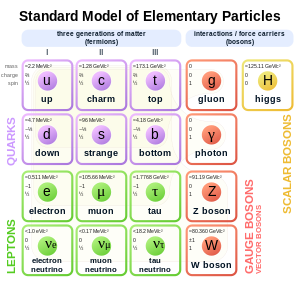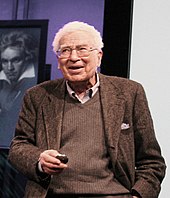4 december 2016
4 december 2016
A quark (/ˈkwɔːrk/ or /ˈkwɑːrk/) is an elementary particle and a fundamental constituent of matter. Quarks combine to form composite particles called hadrons, the most stable of which are protons and neutrons, the components of atomic nuclei.[1] Due to a phenomenon known as color confinement, quarks are never directly observed or found in isolation; they can be found only within hadrons, such as baryons (of which protons and neutrons are examples) and mesons.[2][3]
For this reason, much of what is known about quarks has been drawn from observations of the hadrons themselves.
Quarks have various intrinsic properties, including electric charge, mass, color charge, and spin.
Quarks are the only elementary particles in the Standard Model of particle physics to experience all four fundamental interactions, also known as fundamental forces (electromagnetism, gravitation, strong interaction, and weak interaction), as well as the only known particles whose electric charges are not integer multiples of the elementary charge.
There are six types of quarks, known as flavors: up, down, strange, charm, top, and bottom.[4]
Up and down quarks have the lowest masses of all quarks.
The heavier quarks rapidly change into up and down quarks through a process of particle decay: the transformation from a higher mass state to a lower mass state.
Because of this, up and down quarks are generally stable and the most common in the universe, whereas strange, charm, bottom, and top quarks can only be produced in high energy collisions (such as those involving cosmic rays and in particle accelerators).
For every quark flavor there is a corresponding type of antiparticle, known as an antiquark, that differs from the quark only in that some of its properties have equal magnitude but opposite sign.
The quark model was independently proposed by physicists Murray Gell-Mann and George Zweig in 1964.[5]
Quarks were introduced as parts of an ordering scheme for hadrons, and there was little evidence for their physical existence until deep inelastic scattering experiments at the Stanford Linear Accelerator Center in 1968.[6][7] Accelerator experiments have provided evidence for all six flavors. The top quark was the last to be discovered at Fermilab in 1995.[5]
4 december 2016
A proton is composed of two up quarks, one down quark, and the gluons that mediate the forces "binding" them together. The color assignment of individual quarks is arbitrary, but all three colors must be present.
| Composition | Elementary particle |
|---|---|
| Statistics | Fermionic |
| Generation | 1st, 2nd, 3rd |
| Interactions | Electromagnetism, gravitation, strong, weak |
| Symbol | q |
| Antiparticle | Antiquark ( q ) |
| Theorized |
|
| Discovered | SLAC (c. 1968) |
| Types | 6 (up, down, strange, charm, top, and bottom) |
| Electric charge | + 2⁄3 e, − 1⁄3 e |
| Color charge | Yes |
| Spin | 1⁄2 |
| Baryon number | 1⁄3 |
4 december 2016
A quark (/ˈkwɔːrk/ or /ˈkwɑːrk/) is an elementary particle and a fundamental constituent of matter. Quarks combine to form composite particles called hadrons, the most stable of which are protons and neutrons, the components of atomic nuclei.[1] Due to a phenomenon known as color confinement, quarks are never directly observed or found in isolation; they can be found only within hadrons, such as baryons (of which protons and neutrons are examples) and mesons.[2][3]
For this reason, much of what is known about quarks has been drawn from observations of the hadrons themselves.
Quarks have various intrinsic properties, including electric charge, mass, color charge, and spin.
Quarks are the only elementary particles in the Standard Model of particle physics to experience all four fundamental interactions, also known as fundamental forces (electromagnetism, gravitation, strong interaction, and weak interaction), as well as the only known particles whose electric charges are not integer multiples of the elementary charge.
There are six types of quarks, known as flavors: up, down, strange, charm, top, and bottom.[4]
Up and down quarks have the lowest masses of all quarks.
The heavier quarks rapidly change into up and down quarks through a process of particle decay: the transformation from a higher mass state to a lower mass state.
Because of this, up and down quarks are generally stable and the most common in the universe, whereas strange, charm, bottom, and top quarks can only be produced in high energy collisions (such as those involving cosmic rays and in particle accelerators).
For every quark flavor there is a corresponding type of antiparticle, known as an antiquark, that differs from the quark only in that some of its properties have equal magnitude but opposite sign.
The quark model was independently proposed by physicists Murray Gell-Mann and George Zweig in 1964.[5]
Quarks were introduced as parts of an ordering scheme for hadrons, and there was little evidence for their physical existence until deep inelastic scattering experiments at the Stanford Linear Accelerator Center in 1968.[6][7] Accelerator experiments have provided evidence for all six flavors. The top quark was the last to be discovered at Fermilab in 1995.[5]
4 december 2016
Contents
- 1 Classification
- 2 History
- 3 Etymology
- 4 Properties
- 5 Interacting quarks
- 6 See also
- 7 Notes
- 8 References
- 9 Further reading
- 10 External links
 Six of the particles in the Standard Model are quarks (shown in purple).
Six of the particles in the Standard Model are quarks (shown in purple).
Each of the first three columns forms a generation of matter.
4 dec. 2016.The Standard Model is the theoretical framework describing all the currently known elementary particles.
This model contains six flavors of quarks (
q
), named up (
u
), down (
d
), strange (
s
), charm (
c
), bottom (
b
), and top (
t
).[4] Antiparticles of quarks are called antiquarks, and are denoted by a bar over the symbol for the corresponding quark, such as
u
for an up antiquark.
As with antimatter in general, antiquarks have the same mass, mean lifetime, and spin as their respective quarks, but the electric charge and other charges have the opposite sign.[8]
Quarks are spin- 1⁄2 particles, implying that they are fermions according to the spin-statistics theorem.
They are subject to the Pauli exclusion principle, which states that no two identical fermions can simultaneously occupy the same quantum state.
This is in contrast to bosons (particles with integer spin), any number of which can be in the same state.
[9] Unlike leptons, quarks possess color charge, which causes them to engage in the strong interaction.
The resulting attraction between different quarks causes the formation of composite particles known as hadrons (see "Strong interaction and color charge" below).
The quarks that determine the quantum numbers of hadrons are called valence quarks; apart from these, any hadron may contain an indefinite number of virtual (or sea) quarks, antiquarks, and gluons, which do not influence its quantum numbers.[10] There are two families of hadrons: baryons, with three valence quarks, and mesons, with a valence quark and an antiquark.[11]
The most common baryons are the proton and the neutron, the building blocks of the atomic nucleus.[12]
A great number of hadrons are known (see list of baryons and list of mesons), most of them differentiated by their quark content and the properties these constituent quarks confer.
The existence of "exotic" hadrons with more valence quarks, such as tetraquarks (
q
q
q
q
) and pentaquarks (
q
q
q
q
q
), has been conjectured[13] but not proven.[nb 1][13][14][15][16] However, on 13 July 2015, the LHCb collaboration at CERN reported results consistent with pentaquark states.[17]
Elementary fermions are grouped into three generations, each comprising two leptons and two quarks.
The first generation includes up and down quarks, the second strange and charm quarks, and the third bottom and top quarks. All searches for a fourth generation of quarks and other elementary fermions have failed,[18][19] and there is strong indirect evidence that no more than three generations exist.[nb 2][20][21][22] Particles in higher generations generally have greater mass and less stability, causing them to decay into lower-generation particles by means of weak interactions.
Only first-generation (up and down) quarks occur commonly in nature.
Heavier quarks can only be created in high-energy collisions (such as in those involving cosmic rays), and decay quickly; however, they are thought to have been present during the first fractions of a second after the Big Bang, when the universe was in an ex
tremely hot and dense phase (the quark epoch).
Studies of heavier quarks are conducted in artificially created conditions, such as in particle accelerators.[23]
Having electric charge, mass, color charge, and flavor, quarks are the only known elementary particles that engage in all four fundamental interactions of contemporary physics: electromagnetism, gravitation, strong interaction, and weak interaction.[12] Gravitation is too weak to be relevant to individual particle interactions except at extremes of energy (Planck energy) and distance scales (Planck distance). However, since no successful quantum theory of gravity exists, gravitation is not described by the Standard Model.
See the table of properties below for a more complete overview of the six quark flavors' properties.
4 decemberEnd
History
Murray Gell-Mann at TED in 2007. Gell-Mann and George Zweig proposed the quark model in 1964.
The quark flavors were given their names for several reasons.
The up and down quarks are named after the up and down components of isospin, which they carry.[52] Strange quarks were given their name because they were discovered to be components of the strange particles discovered in cosmic rays years before the quark model was proposed; these particles were deemed "strange" because they had unusually long lifetimes.[53]
Glashow, who coproposed charm quark with Bjorken, is quoted as saying, "We called our construct the 'charmed quark', for we were fascinated and pleased by the symmetry it brought to the subnuclear world."[54]
The names "bottom" and "top", coined by Harari, were chosen because they are "logical partners for up and down quarks".[41][42][53] In the past, bottom and top quarks were sometimes referred to as "beauty" and "truth" respectively, but these names have somewhat fallen out of use.[55]
While "truth" never did catch on, accelerator complexes devoted to massive production of bottom quarks are sometimes called "beauty factories".[56]
4 dec. 2016


No comments:
Post a Comment